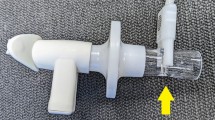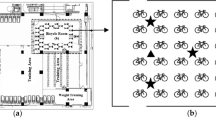Abstract
This study aimed to analyze the risk of infection (influenza and tuberculosis) for individuals participating in physical exercise. This was achieved by assessment of carbon dioxide (CO2) concentrations, and examination of the physical characteristics of a number of gyms to determine whether there was a relationship to CO2 levels. This study was performed in three different gyms ventilated with either split system or central system air conditioners. The risk of airborne infection (percent of susceptible persons infected) was estimated for each gym using the Wells-Riley model. The risk of infection increased during periods of peak occupancy where the ventilation required by occupants was greater. In each gym, the highest risk of infection occurred during the evening where occupancy and CO2 levels were high. The infection risk for influenza was high in all situations due to the high quantum generation rate for this agent. This study suggests that inefficient ventilation in gyms is a significant problem, with high CO2 concentrations resulting in impaired air quality and high health risks to users, including increased risk of infections such as influenza and tuberculosis.





Similar content being viewed by others
References
ACGIH (1991) Documentation of the threshold limit values and biological exposure indices, 6th edn. American conference of governmental industrial hygienists, Cincinnati
Alonso WJ, Viboud C, Simonsen L, Hirano EW, Daufenbach LZ, Miller MA (2007) Seasonality of influenza in Brazil: a traveling wave from the Amazon to the subtropics. Am J Epidemiol 165(12):1434–1442
Alves CA, Calvo AI, Castro A et al (2013) Indoor air quality in two university sports facilities. Aerosol Air Qual Res 13:1723–1730
ASHRAE (2005) Fundamentals handbook. American Society of Heating, Refrigerating and Air-Conditioning Engineers, Inc., Atlanta
ASHRAE (2012) Standard 52.2–2012. Method of testing general ventilation air-cleaning devices for removal efficiency by particle size. American Society of Heating, Refrigerating and Air-Conditioning Engineers, Atlanta
ASHRAE. Standard 62.1 (2004) Ventilation for acceptable indoor air quality. American society of heating, Refrigerating, and Air Conditioning Engineers, Atlanta
ASTM D6245-07 (2007) Standard guide for using indoor carbon dioxide concentrations to evaluate indoor air quality and ventilation. ASTM international, West Conshohocken
Barreira CCS, Carvalho APO (2007) A realidade portuguesa do conforto em instalações de fitness. O que mudar? Motricidade 3(2):69–80
Beggs CB, Noakes CJ, Sleigh PA, Fletcher LA, Siddiqi K (2003) The transmission of tuberculosis in confined spaces: an analytical review of alternative epidemiological models. Int J Tuberc Lung Dis 7:1015–1026
Braniš M, Šafránek J (2011) Characterization of coarse particulate matter in school gyms. Environ Res 111(4):485–491
Braniš M, Šafránek J, Hytychová A (2009) Exposure of children to airborne particulate matter of different size fractions during indoor physical education at school. Build Environ 44:1246–1252
BRASIL – Ministério da Saúde. Agência Nacional de Vigilância Sanitária (ANVISA) (2003) Resolução n° 9 de 16 de janeiro de 2003. Dispõe sobre padrões referenciais de qualidade do ar interior em ambientes climatizados artificialmente de uso público e coletivo. Disponível em: http://portal.anvisa.gov.br/wps/portal/anvisa/anvisa/home
Buonanno G, Fuoco FC, Marini S et al (2012) Particle resuspension in school gyms during physical activities. Aerosol Air Qual Res 12:803–813
Carlisle AJ, Sharp NCC (2001) Exercise and outdoor ambient air pollution. Br J Sports Med 35(4):214–222
Castro A et al (2015) Indoor aerosol size distributions in a gymnasium. Sci Total Environ 524:178–186
Chatzidiakou L, Mumovic D, Summerfield A (2015) Is CO2 a good proxy for indoor air quality in classrooms? Part 2: health outcomes and perceived indoor air quality in relation to classroom exposure and building characteristics. Build Serv Eng Res Technol 36(2):162–181
Clements-Croome DJ, Awbi HB, Bakó-Biró Z, Kochhar N, Williams M (2008) Ventilation rates in schools. Build Environ 43(3):362–367
EPA (1999) Exposure factors handbook. U.S. Environmental Protection Agency, EPA/600/C-99/001
Graudenz GS, Kalil J, Saldiva PH, Gambale W, Latorre MRDO, Morato-Castro FF (2002) Upper respiratory symptoms associated with aging of the ventilation system in artificially ventilated offices in Sao Paulo, Brazil. CHEST J 122(2):729–735
Hug SM, Hansmann R, Monn C, et al (2008) Restorative effects of physical activity in forests and indoor settings. Int J Fit 4(2):25–37
Illinois Department of Public Health Guidelines for Indoor Air Quality (2011) Disponível em http://www.idph.state.il.us/envhealth/factsheets/indoorairqualityguide_fs.htm
Issarow CM, Mulder N, Wood R (2015) Modelling the risk of airborne infectious disease using exhaled air. J Theor Biol 372:100–106
Jones BM, Kirby R, Kolokotroni M, Payne T (2008) Air quality measured in a classroom served by roof mounted natural ventilation windcatchers. Proceedings of the 2008 Conference for the Engineering Doctorate in Environmental Technology. UK
Jung CC, Wu PC, Tseng CH, Su HJ (2015) Indoor air quality varies with ventilation types and working areas in hospitals. Build Environ 85:190–195
Liao CM, Chen SC, Chang CF (2008a) Modeling respiratory infection control measure effects. Epidemiol Infect 136(3):299–308
Liao CM, Chen SC, Chang CF (2008b) Modelling respiratory infection control measure effects. Epidemiol Infect 136:299–308
Massey D, Kulshrestha A, Masih J, Taneja A (2012) Seasonal trends of PM 10, PM 5.0, PM 2.5 & PM 1.0 in indoor and outdoor environments of residential homes located in North-Central India. Build Environ 47:223–231
Nardell EA, Keegan J, Cheney SA, Etkind SC (1991) Airborne infection. Theoretical limits of protection achievable by building ventilation. Am Rev Respir Dis 144:302–306
Noakes CJ, Sleigh PA (2008) Applying the Wells–Riley equation to the risk of airborne infection in hospital environments: the importance of stochastic and proximity effects, In: Proceedings of Indoor Air 2008, International Conference on Indoor Air Quality and Climate, Paper ID: 42, Copenhagen, 17–22 August 2008
Noakes CJ, Sleigh PA (2009) Mathematical models for assessing the role of airflow on the risk of airborne infection in hospital wards. J R Soc Interface
Pegas PN, Alves CA, Evtyugina MG et al (2001) Indoor air quality in elementary schools of Lisbon in spring. Environ Geochem Health 33(5):455–468
Pereira ML, Vilain R, Tribess A (2009) Modeling and measurement of air contaminant distribution in a operating room ventilated with split system. 9th International Conference on Industrial Ventilation. ETH Zurich
Pires da Silva R et al (2009) Salivary immunoglobulin A(s-IgA) and exercise: relevance of its control in athletes and methodological implications. Rev Bras Med Esporte 15(6):459–466
Ramalho O, Wyart G, Mandin C, Blondeau P, Cabanes PA, Leclerc N, Mullot JU, Boulanger G, Redaelli M (2015) Association of carbon dioxide with indoor air pollutants and exceedance of health guideline values. Build Environ 93:115–124
Ramos CA, Wolterbeek HT, Almeida SM (2014) Exposure to indoor air pollutants during physical activity in fitness centers. Build Environ 82:349–360
Ramos CA, Reis JF, Almeida T et al (2015) Estimating the inhaled dose of pollutants during indoor physical activity. Sci Total Environ 527:111–118
Riley EC, Murphy G, Riley RL (1978) Airborne spread of measles in a suburban elementary school. Am J Epidemiol 107(5):421–432
Rudnick SN, Milton DK (2003) Risk of indoor airborne infection transmission estimated from carbon dioxide concentration. Indoor Air 13(3):237–245
Schirmer WN, Szymanski MSE, Gauer MA (2009) Qualidade do ar interno em ambientes climatizados—Verificação dos parâmetros físicos e concentração de dióxido de carbono em agência bancária. Tecno-Lógica 13(1):41–45
Seppänen O, Fisk WJ (2002) Association of ventilation system type with SBS symptoms in office workers. Indoor Air 12(2):98–112
Storla DG, Yimer S, Bjune GA (2008) A systematic review of delay in the diagnosis and treatment of tuberculosis. BMC Public Health 8(1):15
Sze To GN, Chao CYH (2010) Review and comparison between the Wells–Riley and dose-response approaches to risk assessment of infectious respiratory diseases. Indoor Air 20(1):2–16
Tan D, Mulyono S (2010) Determining the indoor air quality. San Jose State University Fitness Center. The Faculty of the Department of General Engineering San Jose State University In Partial Fulfillment of the Requirements for the Degree Master of Science
Vercruyssen M, Kamon E, Hancock PA (2007) Effects of carbon dioxide inhalation on psychomotor and mental performance during exercise and recovery. Int J Occup Saf Ergon 13(1):15–27
Wells WF (1955) Airborne contagion and air hygiene: an ecological study of droplet infections. Cambridge University Press, Cambridge
Wells EM, Berges M, Metcalf M, Kinsella A, Foreman K, Dearborn DG, Greenberg S (2015) Indoor air quality and occupant comfort in homes with deep versus conventional energy efficiency renovations. Build Environ 93:331–338
Wolkoff P (2013) Indoor air pollutants in office environments: assessment of comfort, health, and performance. Int J Hyg Environ Health 216(4):371–394
Woodcock RC (2000) CO2 measurements for IAQ analysis. Occup Health Saf 69(5):56–58 60, 62
Contributors
AA conceived the study, designed the investigation, reviewed the database, analyzed the data, wrote the first draft of the paper, and approved the final submission. FHD collected the data, reviewed the database, analyzed the data, wrote the first draft of the paper, and approved the final submission. MLP conceived the study, designed the investigation, and analyzed the data. CML collected the data, reviewed the database, analyzed the data, and wrote the first draft of the paper. GB reviewed the first draft of the paper and approved the final submission.
Funding
This study was supported by the Higher Education Personnel Improvement Coordination (CAPES), Public notice (no. 03/2015), through masters scholarship and financially supported by FAPESC (Research and Innovation Support Foundation of the State of Santa Catarina) through research (Project No. 2287/PAP 04/2014).
Author information
Authors and Affiliations
Corresponding author
Ethics declarations
Conflict of interest
The authors declare that they have no conflicts of interest.
Additional information
Responsible editor: Philippe Garrigues
Electronic supplementary material
ESM 1
(DOCX 29 kb)
Rights and permissions
About this article
Cite this article
Andrade, A., Dominski, F.H., Pereira, M.L. et al. Infection risk in gyms during physical exercise. Environ Sci Pollut Res 25, 19675–19686 (2018). https://doi.org/10.1007/s11356-018-1822-8
Received:
Accepted:
Published:
Issue Date:
DOI: https://doi.org/10.1007/s11356-018-1822-8




